|
Special Features





Image Libraries


|
|
Blog
GGW links to a WaPo story and slideshow unveiling the six starchitect proposals for the new National Museum of African American History and Culture.
I hate them all. Every single one of them ignores the context of the National Mall and pretends to be a lone sculptural statement. Every single one would make the Mall harder to appreciate as a formal whole.
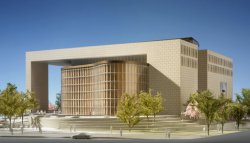 |
Devrouax: Derivative of the National Gallery East Wing, only boring. Almost a total lack of human-scale details. |
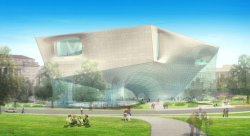 |
Diller: Slick CAD rendering, but what would this even look like in real life? An utterly incomprehensible and ridiculous proposal. |
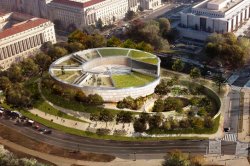 |
Foster: A suburban bunker invisible from the street. Totally the wrong building for the context. |
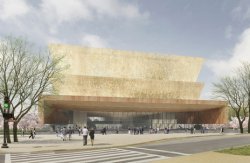 |
Freelon: Didn’t society already collectively agree that brutalism sucks? |
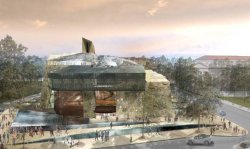 |
Moody: A good design if this were a museum about mining located somewhere in the mountains. A giant stone slab facing the street is not good urbanism. It’s not interesting either. |
 |
Moshe: Probably the least offensive of the lot, but will someone explain to me why glass curtain walls and wavy Gehry lines are taken seriously as “progressive”. |
See the WaPo slideshow for larger images
The National Mall is not a sculpture garden writ large. It is a formal “outdoor room” to be framed by buildings that collectively add to a whole greater than the sum of their parts. It’s an embarrassment to the architecture profession that the so-called best and brightest are so constrained by the dogma of modernism that not one of six teams even tried to present a context-sensitive design. Will a real architect – one interested in designing buildings for a city rather than a lone hilltop – please stand up?
Average Rating: 4.5 out of 5 based on 199 user reviews.
March 30th, 2009 | Permalink
Tags: architecture

|
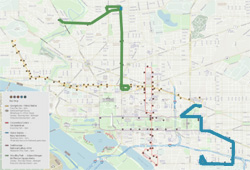
The Circulator map with new routes highlighted |
As of Sunday, the DC Circulator has expanded and is running two new routes: 14th Street – Adams Morgan – Woodley Park and Union Station – Capitol Hill – Ballpark.
The 14th Street – Adams Morgan route in particular is really exciting. In addition to the low-fare, every 10 minute service, the hours are good (until midnight during the week, 3:00 am on the weekends) and, if the new route map is to be believed, the service will be a MetroExtra-like limited-stop deal. The map shows only 7 stops along the entire length of the route, at Franklin Square, 14th/P, 14th/U, Columbia Heights Metro, 16th Street, Columbia/Adams Mill, and Woodley Park Metro. Like the new S9, it will probably be faster between downtown and Mid-City than Metrorail. Very, very cool.
Average Rating: 4.7 out of 5 based on 201 user reviews.
March 30th, 2009 | Permalink
Tags: transportation

|

The Columbia Pike streetcar, conceptual drawing only. |
The website Trains for America picked up a story from the Lynchburg News & Advance about a State Senator from Harrisonburg criticizing VDOT for VDRPT’s new Lynchburg-DC-NY train (you know, the one BeyondDC posted about yesterday). Clueless anti-transit Republicans in rural Virginia aren’t really blogworthy, but the article did include one interesting nugget: A State Delegate from Lynchburg, while defending the new rail service, pointed out that the cost of the Lynchburg train is less than the $20 million it costs to design and build a one-mile stretch of new road.
$20 million for one-mile of road!
Obviously that’s a generality, and it’s not clear what kind of road the Delegate was speaking in regards to. Probably not a small local street, since developers usually build those rather than the state, and certainly not an Interstate-grade highway or anything like one, since the per mile cost of the ICC is $143 million. Most likely the Lynchburg delegate was speaking in regards to an average surface arterial street, something like Glebe Road or Stringfellow Road.
To put that number in context, the Columbia Pike streetcar will cost $27 million per mile according to Arlington County (including the cost to tear the street up and install tracks). That means it costs only marginally more to rebuild a mile of street with a streetcar than it costs to construct a mile of typical street in the first place. That of course implies that if you do it all at once, the streetcar cost turns out to be only a small percentage of the total.
Consider the thousands of miles of arterial and collector streets in the Washington region. Consider the transit system we could have, if only we cared to have it.
Average Rating: 4.6 out of 5 based on 277 user reviews.
March 27th, 2009 | Permalink
Tags: transportation

Next week the 16th Street bus line will become the latest to get the MetroExtra treatment. I’m not sure if any of the buses will actually use the MetroExtra paint scheme, but the service will be reworked to provide both local and express buses. The schedule and map for the express S9 route are available here (H/T Dr. Gridlock).
Will this be a faster way to get from McPherson to Columbia Heights? I picked a random start time (4:00 pm) and plugged it into WMATA’s trip planner to compare the travel time of Metrorail to S9 bus. Trip planner says it takes 26 minutes to make the trip via Metro (with a 9 minute layover at L’Enfant), while the S9’s schedule says it will take only 15 on the new express bus. 26-9=17, so even discounting wait time and going strictly by travel time, the bus should be faster. Of course you have to wait for the bus too, but the S9 will have Metro-like 10 minute headways, so wait time should be about a wash.
The S9 will have limited hours, but it seems that if you’re moving between Mid-City and downtown during those hours it could very well be a faster option than the train. I’ll definitely be trying it out.
PS: Don’t take this post as an endorsement of BRT as superior to rail in an overall sense. I’m talking speed here, but there are numerous other ways Metro is vastly superior to any bus. At the very, very least it is worth mentioning that the S9 will have a harder time sticking to its schedule, since it will be operating in mixed-traffic. Being better than a typical bus isn’t the same as being better than rail.
Average Rating: 4.8 out of 5 based on 197 user reviews.
March 26th, 2009 | Permalink
Tags: featured post, transportation

The Commonwealth of Virginia and Amtrak have come to an agreement to run four new commuter-oriented trains per day. Two new round trips per day between Lynchburg/New York and Richmond/New York will begin to operate by the end of this year. The new trains are on top of existing Amtrak service in those corridors (currently 7/day to Richmond and just 1/day to Lynchburg). In addition to riders from Richmond and Lynchburg, the new trains will benefit existing riders on both VRE lines as well as commuters up and down the Northeast Corridor. Charlottesville also stands to benefit, with triple its current rail service.
While four new train runs per day is hardly revolutionary, incremental improvements like this are an important part of the restoration of American passenger rail. A few extra slow-speed trains may not make a big difference in DC-to-NY travel, but with three trains instead of one, Charlottesville and Lynchburg just became much more rail accessible.
Update 3/26/09: Commenter RichardAtCourthouse says it will only be one new round trip to each destination instead of two. Can anyone confirm either way?
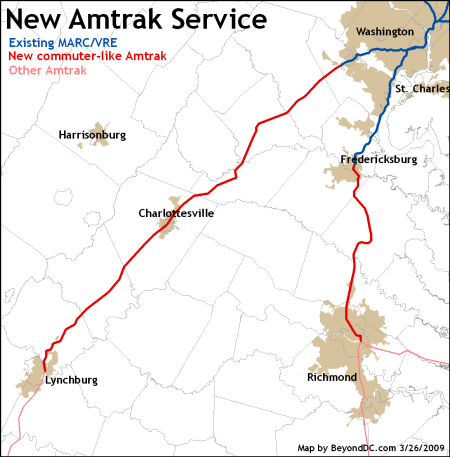
The Virginia portion of the new service.
Average Rating: 4.4 out of 5 based on 234 user reviews.
March 26th, 2009 | Permalink
Tags: transportation

BeyondDC was down most of Wednesday. This was caused by a technical issue with our host which should now be resolved.
Just a reminder that any time the main site goes offline you can use the twitter feed to check status.
Average Rating: 4.7 out of 5 based on 174 user reviews.
March 25th, 2009 | Permalink
Tags: site

|
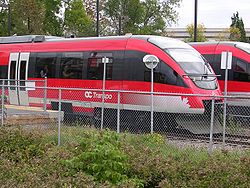
After years of exclusive BRT, Ottawa built this. |
For years Bus Rapid Transit proponents have said that BRT can be just as effective as rail, but at a lower cost. As supposed evidence that rail is unnecessary, for years BRT proponents cited two cities that have relied exclusively on BRT – Ottawa and Curitiba, Brazil.
Alas, in 2001 Ottawa decided it needed trains, so the BRT crowd stopped talking about Ottawa. Curitiba, they said, Curitiba has got the answer.
I wonder what BRT proponents will say now that Curitiba is building a rail system. Apparently, and who could have ever guessed, even the poster children of BRT need rail on some corridors.
As I’ve said before and will no doubt say again: BRT is great on its own terms, but it is not the same as rail service and cannot fully replicate all the things trains can do. We should implement BRT all over the region, but as a way to make surface buses better, not as a cheap substitute for rail.
Average Rating: 4.4 out of 5 based on 217 user reviews.
March 23rd, 2009 | Permalink
Tags: transportation

|
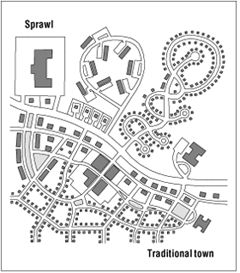
Coming soon all over Virginia: More of the bottom one. |
One of the keystone rules of good urbanism is that interconnected streets are better than disconnected ones. Traditional blocks connected by a grid (or something like a grid) reduce congestion and improve safety by eliminating the bottlenecks inherent in the arterial-collector street system, which funnels all traffic in a given area onto just one or two roads. With a grid, you get options. The transportation eggs aren’t all in one basket.
Good on Virginia then for adopting new regulations requiring future subdivisions to include through streets linking them directly with other neighborhoods nearby. This is a relatively minor modification to long-standing VDOT regulations for new streets, but over time it’s going to make a huge difference to how development in Virginia works. It’s a bona fide statement by the government of the Commonwealth that the old arterial-collector system doesn’t work, and it’s time to move on.
Great news.
Update 3/26/09: Greater Greater Washington outlines the specifics of the new regulations.
Average Rating: 4.4 out of 5 based on 233 user reviews.
March 23rd, 2009 | Permalink
Tags: government, The New America, transportation

|

Cyclists in Copenhagen are safe even without helmets, thanks to all the other cyclists around them. Photo courtesy Copenhagen Cycle Chic |
CityPaper recently published an article sensationalizing the topic of bike helmets. Anybody who doesn’t wear one, claims CityPaper, is a fool.
That just isn’t the case. While it’s true that mountain bikers and racers should always wear helmets, the situation is quite a bit more complicated for urban cyclists riding on mixed streets for transportation.
1) A helmet won’t save you from the big danger of urban cycling – getting hit by a larger vehicle.
2) The very safest thing for cyclists in the city is for there to be lots of other cyclists in the city around them, and if everybody thinks they need special equipment any time they want to ride a bike, that reduces the number of cyclists on the street.
When it comes to biking, there is big time safety in numbers. Drivers who see a lot of cyclists around know they have to share the road and drive carefully. On the other hand, if there are few cyclists, then drivers don’t expect them to be there, don’t watch for them, and drive in a manner that increases the danger to cyclists. After all, if you’re not looking out for something, how can you avoid it? Studies have shown that adult helmet laws dramatically reduce cycling use. If there’s safety in numbers, that’s counter-productive; helmet laws actually make cycling more dangerous, rather than safer.
So as a cyclist, the safest things you can do are to bike more and encourage other people to bike more. Not owning a helmet, or not having one handy all the time, shouldn’t dissuade anyone from riding because every time there is one less cyclist on the road that makes the road more dangerous. Of course wearing a helmet doesn’t hurt and is generally a good idea, but don’t let the absense of a helmet ever prevent you going somewhere by bike.
The Examiner has more.
Average Rating: 4.4 out of 5 based on 237 user reviews.
March 20th, 2009 | Permalink
Tags: featured post, transportation

This file is getting long. Today’s entry is that according to the latest county-level US Census data, the long migration from central city to outer suburbs is reversing. For decades DC has gotten smaller each year, the inner suburbs have grown very slowly, and the outer suburbs have boomed. That isn’t what’s happening now.
Growth Between July 2007 and July 2008, ranked by rate:
Loudoun up 13, 000 (4.6%) to 290, 000
Arlington up 6, 000 (3%) to 210, 000
Alexandria up 4, 000 (2.9%) to 144, 000
Prince William up 5, 000 (1.4%) to 366, 000
Fairfax up 11, 000 (1.1%) to 1, 015, 000
Montgomery up 9, 000 (1%) to 951, 000
Howard up 2, 000 (0.9%) to 275, 000
DC up 4, 000 (0.7%) to 592, 000
Frederick up 1, 500 (0.7%) to 226, 000
Anne Arundel up 2, 000 (0.4%) to 513, 000
Charles up 600 (0.4%) to 141, 000
Prince George’s down 4, 500 (-0.5%) to 821, 000
Two of the region’s three fastest-growing jurisdictions are located completely inside the Beltway, and the District of Columbia is now growing at the same rate or faster than four of the six counties in suburban Maryland. As recently as two or three years ago, such data would have been absolutely unthinkable.
Nationally the trend is visible is some cities, but not all. I looked up three other large American central cities that double as counties (Denver, San Francisco, Baltimore) and found uneven results. Denver is growing faster than all but one of its suburbs, San Francisco ranks near the middle of Bay Area counties, and poor Baltimore is still shrinking. But even if this cities-growing-faster-than-suburbs thing isn’t being seen completely across the board, it does at least seem fair to say that the playing field of city to suburb growth is rapidly leveling.
Avent has more.
Update: Here’s another interesting way of looking at our region: The combined population total of the three central jurisdictions (DC, ArCo, Alexandria) is now 945, 687, up a total of 14, 062 from 2007 (1.5%). The combined population total of the three Beltway jurisdictions (Fairfax, Montgomery, PG) is now 2, 786, 834, up a total of 15, 874 from 2007 (0.6%). Even without PG to drag them down, Fairfax and Montgomery combined are barely growing at 1%. At this point, the core is definitely outperforming the Beltway by a sizable margin.
Average Rating: 4.5 out of 5 based on 259 user reviews.
March 19th, 2009 | Permalink
Tags: The New America

|
Media





Site
About BeyondDC
Archive 2003-06
Contact
Category Tags:
Partners
|

























